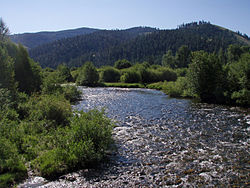NRCSNV00006 - Nevada (5497)(NRCS Photo Gallery)
Lahontan Cutthroat Trout (Oncorhynchus clarki henshawi).
- From Pyramid Lake within the Pyramid Lake Indian Reservation, located in Washoe County, northwestern Nevada.
| This image is a work of the Natural Resources Conservation Service, part of the United States Department of Agriculture, taken or made as part of an employee's official duties. As a work of the U.S. federal government, the image is in the public domain in the United States.
It was taken from the NRCS Photo Gallery. The NRCS Photo Gallery contains natural resource and conservation related photos from across the USA. The Gallery is a joint project between NRCS Conservation Communications and the NRCS Information Technology Center in Ft. Collins, Colorado. There is no charge to enhance your web site, newsletter, brochure, presentation, publication, or desktop with NRCS Photo Gallery photos.source If you use any of these photos in a publication, on a web site, or as part of any other project, it is requested but not compulsory that you use one of the following credit lines:
These photos may not be used to infer or imply NRCS endorsement of any product, company, or position. Please do not distort or alter the images the photos portray. |
Relevante Bilder
Relevante Artikel
Cutthroat-ForelleDie Cutthroat-Forelle ist ein Süßwasser-Fisch aus der Familie der Lachsfische. Sie ist in den kalten Flüssen und Bächen des Pazifischen Beckens in Nordamerika beheimatet und kommt in den Küstengebirgen des Pazifiks, dem Großen Becken und den Rocky Mountains vor. Die Cutthroat-Forelle, eine pazifische Forelle, gehört zur Gattung Oncorhynchus, zu der auch die Regenbogenforellen gerechnet werden. Der Name Cutthroat rührt von der roten Färbung auf der Unterseite des Unterkiefers her. Die Bezeichnung clarkii wurde zu Ehren des Entdeckers William Clark, eines der Führer der Lewis-und-Clark-Expedition, gegeben. Cutthroat-Forellen bewohnen kleine bis mittlere Flüsse und Bäche mit kaltem, sauerstoffreichem Wasser und Kiesgrund alluvialer oder Felsgrundfließgewässer, dem typischen Habitat der Westküste. Cutthroat-Forellen laichen im Frühjahr und vermischen sich dabei durch natürliche Hybridisierung mit Regenbogenforellen. Die beiden Arten können fruchtbare Nachkommen bilden. Einige der küstennahen Populationen von Oncorhynchus clarkii sind anadrom. .. weiterlesen

















